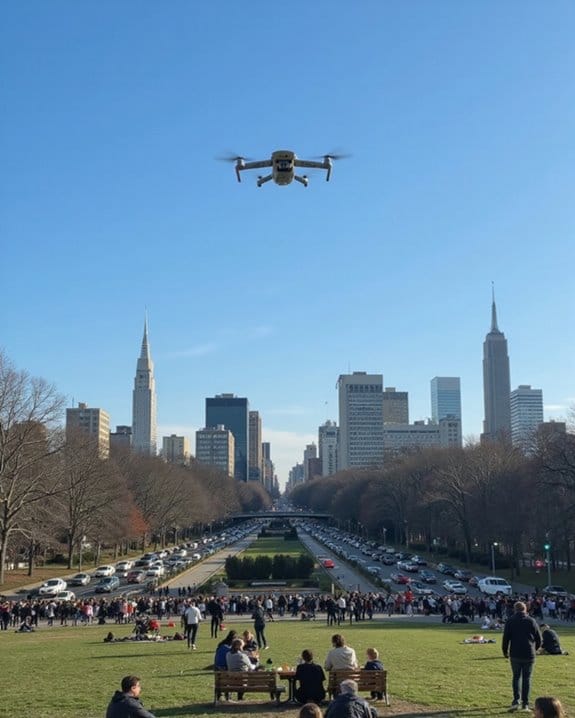You’re seeing more drones in the UK sky at night mainly because of a surge in surveillance near military bases and critical sites. These aren’t your average hobby models—many fly in tight, coordinated swarms with bright lights, moving almost silently or with a hum. Authorities and the military are ramping up patrols due to espionage concerns, but sometimes, it’s just civilian operators or misidentified aircraft. Want to know how these drones manage such perfect nighttime flights and what’s being done about it?
Key Takeaways
- Many nighttime drone flights are suspected covert surveillance near sensitive sites like RAF bases and US airbases.
- Some drones may be used by foreign actors for espionage or intelligence gathering over military and critical infrastructure.
- Civilian hobbyists and legal operators also contribute to nighttime drone activity, sometimes causing misidentification and public alarm.
- Authorities are investigating the incidents, increasing patrols and security, but have not publicly identified the operators or intent.
- Public concern over privacy and security has grown due to unexplained flights and lack of official transparency about drone operations.
Recent Surge in Nighttime Drone Sightings Across the UK
Why have drones become such a common sight over the UK’s night skies lately? You might’ve noticed a sharp rise in drone sightings, especially after dark. Recent reports highlight brightly lit objects hovering over RAF bases, triangle-shaped crafts with lights and noise, and even slow-moving orange flames cruising the night sky. Here’s what sets the current surge apart:
Key Observations:
- Multiple coordinated drone sightings at night—often near military sites.
- Triangle-shaped aerial vehicles with distinctive lighting.
- Hundreds of lights flying in precise formations, suggesting advanced coordination.
- Interactive maps now track these drone sightings, helping you spot emerging patterns across the UK.
If you’re scanning the night sky, expect more activity, especially near sensitive locations. Stay tuned as we break down the implications of these nocturnal drone appearances. Many of these drones are equipped with advanced night vision capabilities and GPS tracking to enable precise operations in low-light conditions.
Key Locations Targeted: Airbases and Infrastructure
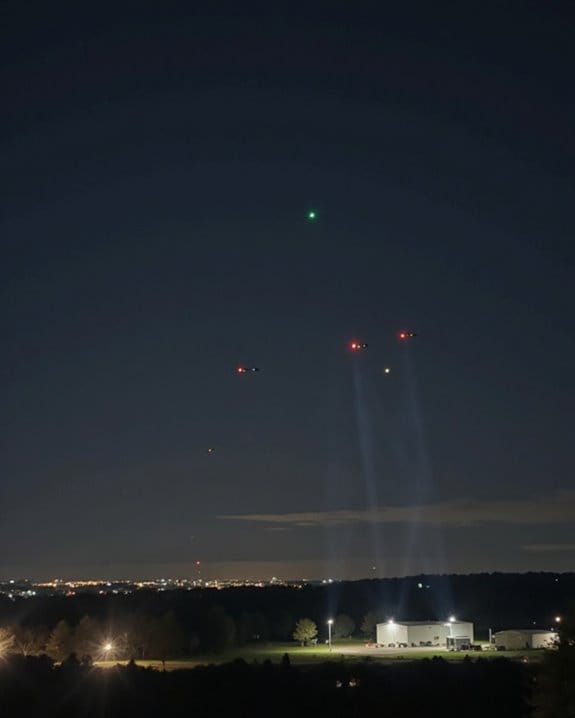
When it comes to nighttime drone activity, the UK’s most sensitive sites are bearing the brunt. You’ll notice drones aren’t just randomly buzzing the skies—they’re focusing on critical infrastructure, especially RAF airbases and important military zones. Here’s a breakdown:
Key Targeted Locations:
- *RAF Lakenheath, RAF Mildenhall, RAF Feltwell*: Multiple sightings of triangle-shaped and brightly lit drones between November 20-22.
- *RAF Boulmer*: Bright objects spotted near this crucial surveillance base, including one 18 miles south.
- *RAF Wyton (Huntingdon)*: Coordinated lights, interpreted as drones, observed near this intelligence hub.
- *Hockwold cum Wilton*: Drone activity between interconnected RAF bases.
- *HMS Queen Elizabeth (Port of Hamburg)*: Drone came within 250 meters, highlighting maritime threats.
Stay alert—these aren’t your average hobbyist drones. Many of these drones likely meet military-grade specifications, ensuring they can operate effectively in challenging environments.
Eyewitness Accounts: What Residents Are Seeing
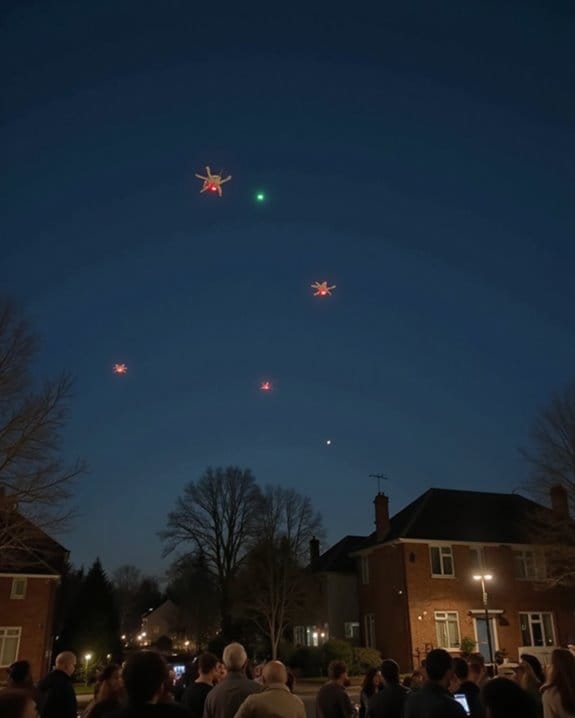
After pinpointing the main targets of recent nighttime drone activity, it’s worth examining what locals have actually witnessed on the ground.
Overview of Sightings
You might have noticed an uptick in sightings of drones in the sky, especially near places like Beck Row, Suffolk. Residents have reported:
- Triangle-shaped, grey aerial vehicles: These are noisy, with lights, and were spotted between 20–22 November.
- Brightly lit, hovering objects: Sometimes, these drones in the sky are completely silent—no engine noise at all.
- Official-looking craft: Locals, including Casseem Campbell, questioned their identity during incursions near RAF bases.
- Increased aerial activity: Johnny Whitfield described frequent overflights of both drones and planes, with little comment from US military personnel.
Practical tip: If you spot unusual drones, note the shape, lights, and any noise for accurate reporting. Many modern surveillance drones now feature enclosed propellers to reduce noise and enhance safety during covert operations.
Security Responses and Heightened Military Presence
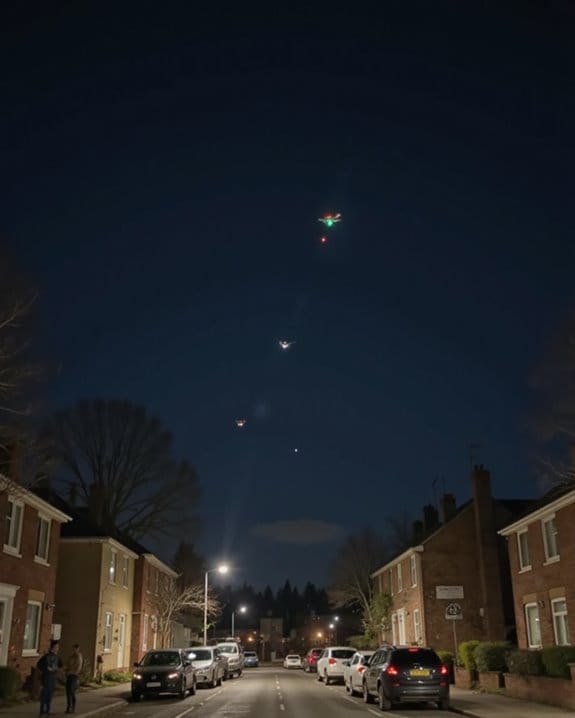
Though the recent surge in nighttime drone sightings has stirred local curiosity, the official response has been anything but casual. If you’re near RAF bases like Mildenhall or Lakenheath, you’ve likely noticed a sharp uptick in law enforcement and military personnel. Here’s a quick breakdown of the security measures now in place:
Heightened Security Initiatives:
- British troops assisting US forces to track drone operators
- Military jeeps and police patrols increasing near Beck Row
- US Air Force investigators engaging residents for intel
- Pilots switching to encrypted data links for communications
- Ministry of Defence conducting live criminal investigations
These coordinated efforts are designed to safeguard public safety and deter illegal drone activity near sensitive sites. If you spot unusual activity, don’t worry—security teams are on high alert, and your skies aren’t being left unguarded.
Theories Behind the Drone Incursions
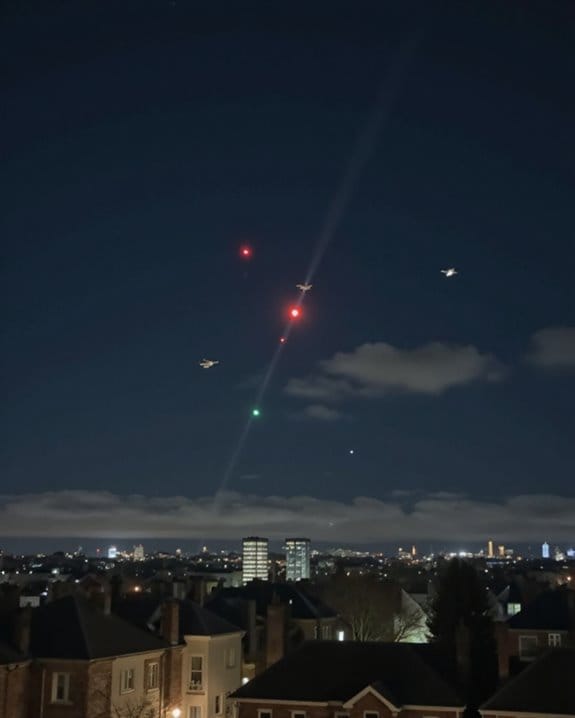
While the stepped-up security measures have been hard to miss around UK airbases, the motives behind these nighttime drone flights remain a subject of heated discussion.
Overview of Theories
You’ll find several competing explanations for the mystery drones and sightings of drones over sensitive locations:
- Foreign Espionage: Experts, like Colonel Hamish de Bretton-Gordon, warn these flights might be Kremlin-backed tests or even involve sleeper agents. Other theories point to China or Iran gathering intelligence near RAF sites.
- Civilian Activity: US agencies suggest many sightings of drones could be hobbyists or commercial operators acting within the law.
- Misidentification: Some slow, bright objects could be manned aircraft mistaken for drones.
- Alien Speculation: While some claim extraterrestrial involvement, officials haven’t found evidence—just a few lights and a lot of imagination.
Legal Restrictions and Government Countermeasures
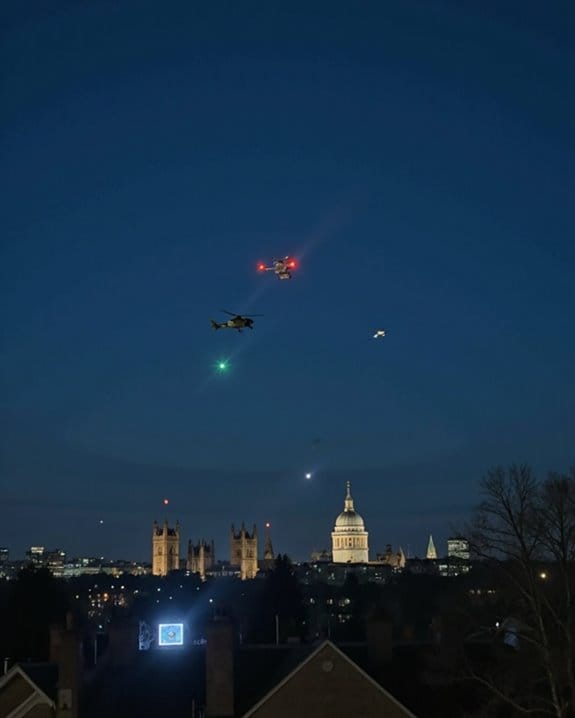
Curious how the UK tackles rogue drones buzzing around at night? Let’s break down the legal restrictions and government countermeasures you need to know.
Legal Restrictions:
- It’s illegal to fly drones near military sites. The Ministry of Defence isn’t joking—they’ve got robust counter-drone capabilities.
- Ongoing criminal investigations mean authorities won’t hesitate to use the full force of the law against anyone compromising national security or public safety.
Government Countermeasures:
- British troops have teamed up with US forces to track and deter unauthorized drone operations, especially around RAF bases.
- The UK takes cues from international partners. For example, the FAA in the US has banned drone flights below 400 feet at certain sites, reflecting growing concerns over nighttime sightings.
Bottom line? Don’t test these boundaries—serious consequences await.
Technology Behind Modern Drones and Their Capabilities
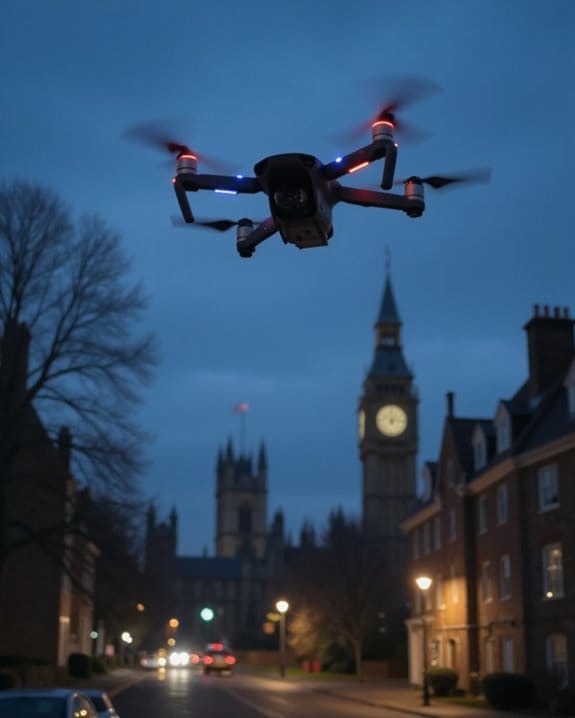
Modern drones aren’t just toys—they’re sophisticated aerial platforms packed with cutting-edge technology. If you’ve noticed drones flying overhead at night, you’re witnessing a revolution in aerial capability. Here’s what sets today’s models apart:
Key Features:
- High-Resolution Cameras: Capture crisp images and videos from a distance.
- Infrared Sensors: Spot heat signatures, making nighttime surveillance a breeze.
- Autonomous Systems: Navigate pre-set routes, avoid obstacles, and self-correct—all without constant human input.
- GPS Integration: Pinpoint accuracy for mapping or reaching hard-to-access locations.
Since the FAA’s 2023 changes, drones flying at night are safer and more common. For hobbyists, consumer drones offer impressive camera tech. Professionals, on the other hand, benefit from enterprise-grade features—think mobile surveillance and detailed mapping—where only a drone can go.
Privacy Concerns Raised by Unidentified Aerial Activity
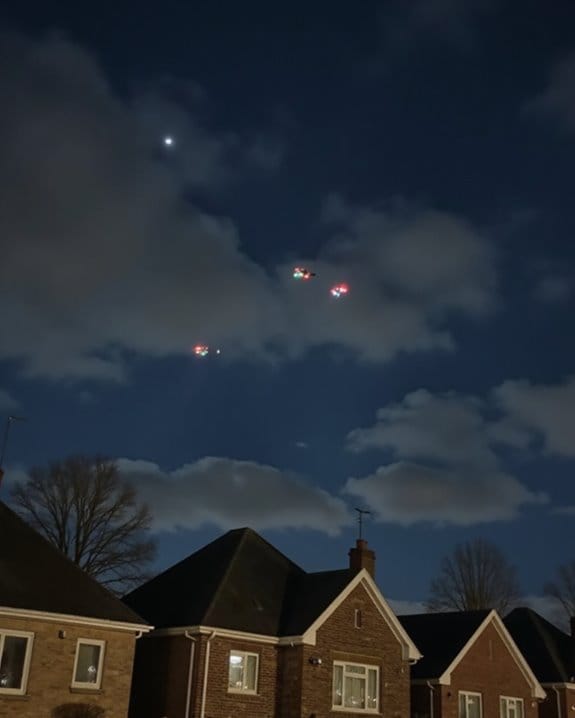
How often have you glanced skyward at night, spotting a blinking light and wondered who—or what—is watching? Those mysterious flying objects aren’t just a marvel; they’re raising real privacy concerns. With advanced cameras and infrared sensors, drones can peer into private spaces—even your backyard—without your permission. Since the FAA allowed nighttime drone flights, the risk of covert surveillance has soared, leaving many uneasy about that unexplained light in the sky.
Privacy groups like EPIC and the ACLU have pushed for safeguards, including requiring drones to broadcast real-time info via smartphone apps. Unfortunately, these calls for transparency have mostly been ignored. If you spot a flying object overhead, you’ve got every reason to question what data it’s collecting—and who’s behind the controls.
Patterns and Behaviors Observed in Drone Flights
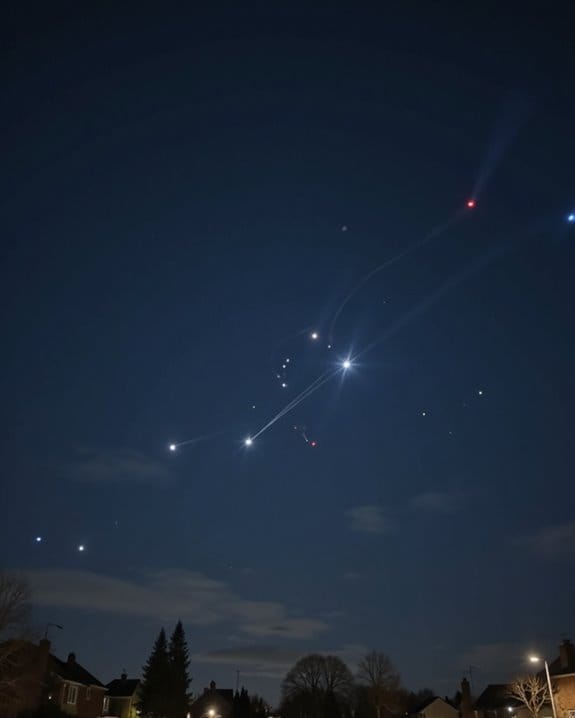
While privacy worries are top of mind, it helps to understand exactly what drones are up to when they’re buzzing overhead at night. You’ll notice distinct patterns:
Flight Characteristics:
- Drones in Huntingdon fly slowly with perfect spacing, mimicking a well-rehearsed aerial dance.
- Most sightings, like in Blackpool at 7pm, occur under cover of darkness.
- In Luton, drones maintain tight formation even when flying against 17mph headwinds—pretty impressive piloting.
Behavioral Observations:
- Near Hockwold cum Wilton, close to RAF Feltwell, groups of about 10 drones circle in obvious coordination.
- In Northampton, a drone hovered almost motionless before vanishing—disappearing acts are common in these night flights.
If you’re tracking aerial activity, watch for these behaviors. They’re more choreography than chaos.
Public Reactions and Ongoing Investigations

Curiously, it’s not just the hum of propellers that’s caught the UK public’s attention—it’s the silence from officials that’s really buzzing. If you’re watching the skies, you’ve likely noticed the rumors swirling as fast as the drones themselves. The views expressed by residents like Casseem Campbell reflect a sense of frustration; social media often outpaces official updates, leaving communities to speculate. Increased police patrols and military vehicles, as reported in Beck Row, only add to local anxiety.
Ongoing investigations are robust. The UK Ministry of Defence, with US forces, treats these incursions seriously, mirroring efforts by the FBI and Department of Homeland Security in the US. Despite public theories of espionage, authorities assure there’s no immediate threat—just persistent uncertainty and unanswered questions.
Frequently Asked Questions
Why Are There Drones Flying Around at Night?
You’re seeing drones at night because operators—like hobbyists, businesses, or even law enforcement—use them for photography, monitoring, or testing. Some could be checking infrastructure or security, while others just enjoy night flying thanks to new rules.
What Does a Police Drone Look Like at Night in the UK?
You’ll spot a police drone at night as a cluster of glowing white, red, or green lights drifting low in the sky. Its compact, quadcopter frame and steady, deliberate movement make it unmistakably official, not just another aircraft.
What Does a Police Drone Look Like in the Sky at Night?
When you spot a police drone at night, you’ll notice bright white, red, or green navigation lights, often appearing as hovering or slow-moving orbs. They’re usually small, quiet, and might look like coordinated or diamond-shaped lights in the sky.
Can Drones Fly at Night in the UK?
Yes, you can fly drones at night in the UK, but you’ll need to follow strict rules. You can’t fly near airports or military sites, and you must keep your drone in sight and under 400 feet.


